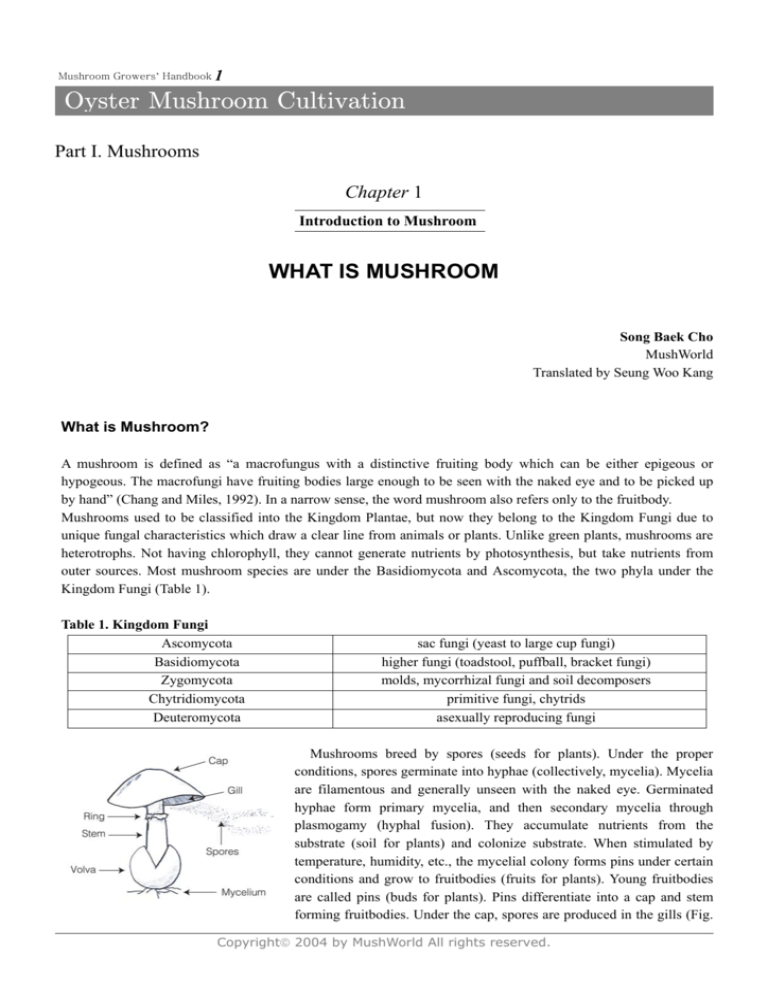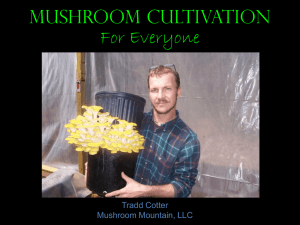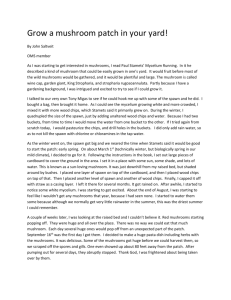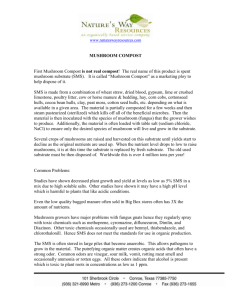
Part I Mushrooms
Mushroom
Growers’ Handbook
Chapter 1. Introduction Mushroom
1
1
Oyster Mushroom Cultivation
Part I. Mushrooms
Chapter 1
Introduction to Mushroom
WHAT IS MUSHROOM
Song Baek Cho
MushWorld
Translated by Seung Woo Kang
What is Mushroom?
A mushroom is defined as “a macrofungus with a distinctive fruiting body which can be either epigeous or
hypogeous. The macrofungi have fruiting bodies large enough to be seen with the naked eye and to be picked up
by hand” (Chang and Miles, 1992). In a narrow sense, the word mushroom also refers only to the fruitbody.
Mushrooms used to be classified into the Kingdom Plantae, but now they belong to the Kingdom Fungi due to
unique fungal characteristics which draw a clear line from animals or plants. Unlike green plants, mushrooms are
heterotrophs. Not having chlorophyll, they cannot generate nutrients by photosynthesis, but take nutrients from
outer sources. Most mushroom species are under the Basidiomycota and Ascomycota, the two phyla under the
Kingdom Fungi (Table 1).
Table 1. Kingdom Fungi
Ascomycota
Basidiomycota
Zygomycota
Chytridiomycota
Deuteromycota
sac fungi (yeast to large cup fungi)
higher fungi (toadstool, puffball, bracket fungi)
molds, mycorrhizal fungi and soil decomposers
primitive fungi, chytrids
asexually reproducing fungi
Mushrooms breed by spores (seeds for plants). Under the proper
conditions, spores germinate into hyphae (collectively, mycelia). Mycelia
are filamentous and generally unseen with the naked eye. Germinated
hyphae form primary mycelia, and then secondary mycelia through
plasmogamy (hyphal fusion). They accumulate nutrients from the
substrate (soil for plants) and colonize substrate. When stimulated by
temperature, humidity, etc., the mycelial colony forms pins under certain
conditions and grow to fruitbodies (fruits for plants). Young fruitbodies
are called pins (buds for plants). Pins differentiate into a cap and stem
forming fruitbodies. Under the cap, spores are produced in the gills (Fig.
Copyright 2004 by MushWorld All rights reserved.
Part I Mushrooms
Chapter 1. Introduction Mushroom
2
1). Fruitbodies release spores in order to produce the next generation.
This life cycle of mushroom is divided into two phases: vegetative and reproductive growth. Vegetative growth
indicates linear growth of fungal mycelia dissolving complex substrate components into simpler molecules and
absorbing them as nutrients. When low temperature, high humidity, much oxygen, and sometimes light are offered,
the mycelia cease vegetative growth and begin to produce fruitbodies, which we call ‘mushroom’. This is
reproductive growth. Mushroom cultivation can be said the practice of obtaining fruitbodies by artificially
repeating these two growing stages.
Mushroom cultivation requires enough understanding on the optimal growing conditions of each mushroom
species and how to make favorable environment for both vegetative and reproductive growth of mushrooms.
Three Factors of Mushroom Cultivation
Spawn
A. Grain spawn
B. Sawdust spawn
C. Plug spawn
D. Liquid spawn
Figure2. Various types of spawn
What spawn is to mushroom is
like seed is to crop. Unlike
spore, spawn is already at its
mycelial stage growing on its
own substrate such as sorghum,
barley or sawdust. The life cycle
of mushroom starts from spores,
but growers inoculate mycelial
origin spawn rather than spore
origin spawn because of
possible
variations
and
mutations. The quality of spawn
is one of the most decisive
factors for successful crop.
Therefore, growers need to use
qualified spawn for commercial
production.
Spawn
should
maintain
the
strain
characteristics and is propagated
by subcultures. New strains are
developed with genetic methods
such as variation and mating.
The various types of mushroom
spawn include grain, sawdust, plug and liquid.
Substrate
Mushrooms can be classified as 3 categories by their tropic pattern; saprophytes, parasites or mycorrhizae. The
most commonly grown mushrooms are saprophytes, decomposers in an ecosystem growing on organic matters
like wood, leaves and straw in nature. Raw materials can be used as substrate for primary decomposers such as
oyster mushroom and enokitake which have lignocellulosic enzymes. On the other hand, secondary decomposers
like button mushroom or straw mushroom require substrate degraded by bacteria or other fungi. Mushroom
requires carbon, nitrogen and inorganic compounds as its nutritional sources and the main nutrients are carbon
sources such as cellulose, hemicellulose and lignin. Thus, most organic matters containing cellulose,
Copyright 2004 by MushWorld All rights reserved.
Part I Mushrooms
Chapter 1. Introduction Mushroom
3
hemicellulose or lignin can be used as mushroom substrate. Examples are cotton, cottonseed hull, corncob,
sugarcane waste, sawdust, and so on. However, demanded amount of each nutritional sources differs according to
mushroom species. For example, button mushroom (Agaricus bisporus) requires relatively high nitrogen source,
so the optimal C/N ratio of button mushroom compost is 17. On the other hand, oyster mushroom and shiitake
require less nitrogen and more carbon source. Mushroom mycelia secrete digestive enzymes into the substrate and
absorb the dissolved nutrients. Cellulose, the main nutritional source of mushroom is one of the most abundant
organic matters on earth, but its digestive enzyme, cellulase is owned by several microorganisms including fungi.
Here comes the reason mushroom is considered an important food source. Mushroom is the only one by which
cellulose is dissolved and absorbed and transformed into food for mankind. Mushroom is also influenced by
acidity of substrate. The optimal pH value of substrate ranges from 6 to 8, varying with mushroom species.
Environment
The last important factor for mushroom growing is providing an appropriate environment both for vegetative and
reproductive growth. Not being protected by a skin layer, fungi are easily affected by their growing conditions. So
it can be said that the success or failure of mushroom cultivation depends on the control of growing conditions.
Environmental factors affecting mushroom cultivation include temperature, humidity, light and ventilation.
Optimal levels of them at vegetative stage differ from those at reproductive stage.
Mushroom mycelia can survive between 5 and 40℃ depending on the species. Mushroom mycelia grow well
with the temperature range between 20 and 30℃. Pins form at 10-20℃, lower than that of mycelial growth by
10℃. Over 80% of the fruitbody is water. Substrate moisture content should be 60-75% and log moisture content,
35-45%. During fruiting, different relative humidity levels, ranging from 80-95%, are needed at the early, mid and
latter stage. Though mycelia can grow without light, some species require light for fruitbody formation. Being
aerobic fungi, mushrooms need fresh air during growing, but ventilation is more required for reproductive stage.
No matter how well the substrate is colonized, it is useless if it fails in fructification. Therefore creating the
optimal conditions for transition from vegetative stage to reproductive stage is crucial to successful mushroom
cultivation.
In conclusion, among the three factors, the most important is environmental control. By maintaining optimal
conditions at each growing stage and for each species, growers can produce the desired yield of quality
mushrooms.
Glossary
• Epigeous Growing on (or close to) the ground.
• Hypogeous Growing under ground.
• Plasmogamy Fusion of cells or protoplasts without fusion of the nuclei, as occurs in higher terrestrial fungi.
Nucleus fusion is called karyogamy.
• Heterotroph An organism that cannot synthesize its own food and that is dependent on complex organic
substances for nutrition. Most organisms except green plants (autotrophs) are heterotrophs.
• Saprophyte An organism which grows on and derives its nutrient from dead or decaying organic matter.
• Parasite An organism that grows, feeds, and is sheltered on or in a different organism while contributing
nothing to the survival of its host.
• Mycorrhiza The symbiotic association of the mycelium of a fungus with the roots of certain plants, such as
conifers, beeches, or orchids.
• Aerobe Organism that is living or occurring only in the presence of oxygen.
Copyright 2004 by MushWorld All rights reserved.









